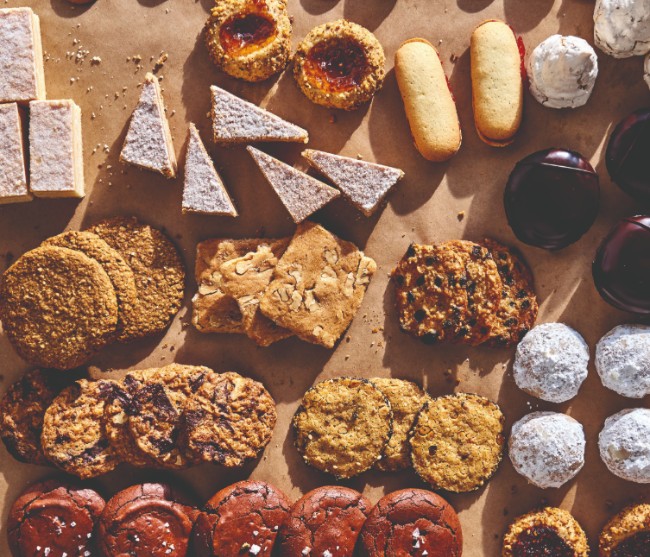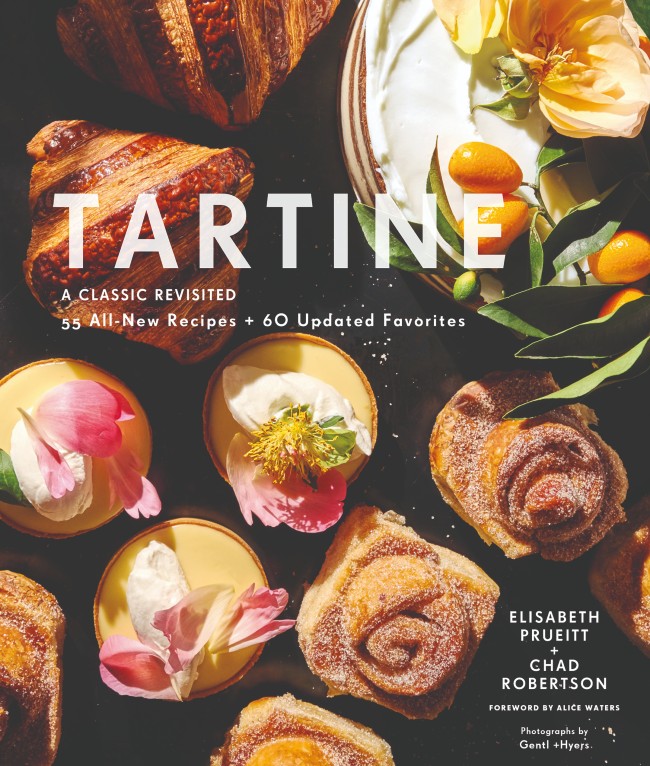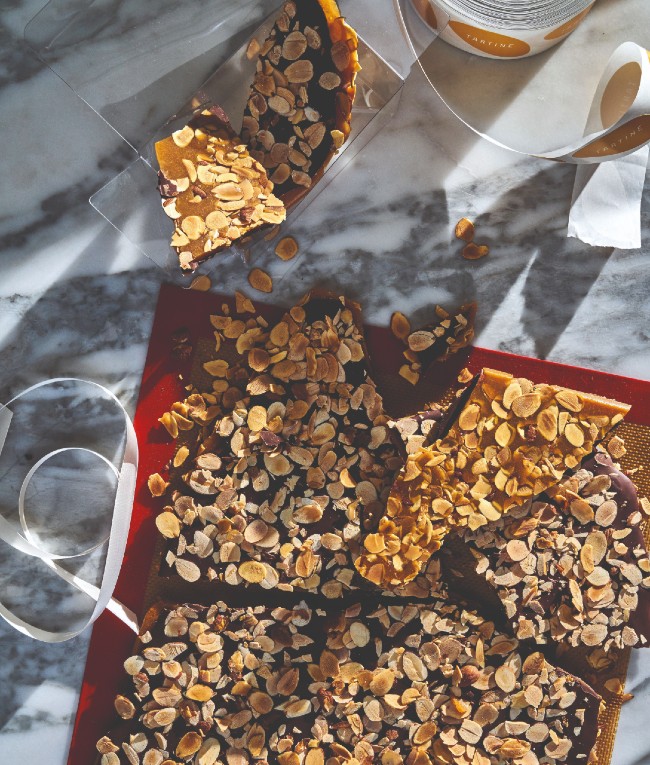Exclusive Recipes from Tartine, the Beloved San Francisco Bakery

Elisabeth Prueitt and husband Chad Robertson, of San Francisco bakery Tartine fame, share recipes from their book, described by the New York Times as one of the “best cookbooks of Fall 2019.”
Excerpts from Tartine: A Classic Revisited by Elisabeth M. Prueitt & Chad Robertson. Photography © Gentl + Hyers. Published by Chronicle Books. Purchase the book on Amazon below.
CANELÉS
Makes: 12 2in (5cm) canelés
Canelés are unlike any other pastry, in a class of their own. They were originally a speciality of Bordeaux, where you still see stores devoted to selling only these unique pastries. They are made in a mould that looks like a miniature 2in (5cm) Bundt form that is coated in a mixture of beeswax and butter, creating a pastry with a caramelised crust and a soft, almost pudding-like interior. They can also be terribly challenging even for the most skilled baker, so it is with a slight amount of caution but with a very trusty recipe that Lynn has developed that we offer you the canelé. If you have patience and love a baking challenge, this is your recipe.
INGREDIENTS
200g confectioners’ sugar
100g all-purpose flour
tsp salt
400ml milk
2 tbsp + 2 tsp unsalted butter
1 vanilla bean, split and scraped
2 large eggs
1 large egg yolk
2 tbsp dark rum
Beeswax coating for canelé moulds
170g unsalted butter
115g food-grade beeswax (organic, if possible)
1 In a large bowl, sift together the confectioners’ sugar, flour and salt. Set aside. Combine the milk and butter in a medium, heavy saucepan and place over medium heat. As soon as the butter is melted, remove the saucepan from the heat and add the vanilla bean seeds. Set aside. In a small bowl, whisk together the eggs and yolk. Pour the egg mixture and the rum into the warmed milk and stir. Gently pour the milk mixture through a fine-mesh sieve set over the sifted dry ingredients. Whisk gently to combine. Pass the batter through the sieve two more times. Add the vanilla pod and refrigerate the batter in a covered container for 48 hours before baking.

Canelés. “Tartine: A Classic Revisited” by Elisabeth M. Prueitt & Chad Robertson. Photography © GENTL + HYERS
2 To prepare the mould coating, clarify the butter by placing it in a small, heavy saucepan and melting it slowly over medium-low heat. The foamy white milk solids will rise to the surface; using a spoon, skim the milk solids from the top of the melted butter. Slowly pour the hot butter through a cheesecloth-lined strainer. Some of the milk solids may remain in the pot. Take care not to let them mix into the clarified butter. You should have 115g. Store, well wrapped, in the refrigerator for up to 2 weeks.
3 To prepare the canelé moulds for baking, preheat the oven to 180°C. Place a wire rack over a foil-lined baking sheet. Have oven mitts or heat-resistant baking gloves ready to protect your hands. In a small, heavy saucepan, heat the clarified butter and beeswax together until completely melted and hot. Arrange the canelé moulds on the wire rack. Very carefully, one at a time, pour the hot beeswax mixture into each mould, filling it completely before tipping the hot mixture back into the pot. Flip and place the empty mould onto the wire rack to allow any excess beeswax to drip out onto the foil-lined sheet, and set upright before the wax sets. Continue this process until all of the moulds are filled, flipped, and drained. If the beeswax mixture begins to cool and set in the pot, place over a low heat to melt thoroughly before continuing. There should be a very thin coat of beeswax lining each mould. Line the baking sheet with a fresh sheet of foil. Place the moulds directly on the pan, evenly spaced in three rows of four.
4 Remove the vanilla pod from the canelé batter and gently stir to combine. Some flour may have settled to the bottom of the container. Carefully fill each mould three-fourths of the way. Bake until the batter has risen slightly and is a very dark mahogany colour, about 45 minutes, rotating the baking sheet halfway through baking. Test for doneness: if the crown of the canelé is still light in colour, replace the mould and continue cooking in 5-minute increments, checking after each round. They should be evenly coloured. Some canelés may be ready before others; continue baking the lighter ones. Turn the canelés out of their moulds immediately. Cool for 20 minutes before serving. They are best eaten the day they are baked.
Matcha canelé variation: When making the batter, omit the vanilla bean and add 1 tsp sifted matcha powder to the milk mixture. Bake as directed.
Citrus canelé variation: When making the batter, omit the vanilla bean. Substitute orange liqueur, such as Grand Marnier, for the rum. Add the finely grated zest of half an orange and half a lemon when pouring the batter into the storage container. Bake as directed.

GOUGÈRES
Makes: 30 11⁄2in (4cm) hors d’oeuvres, or 8 to 10 4in (10cm) pastries
Gougères are made from one of the mainstays of French classical baking, pâte à choux, or choux paste. It is what éclair shells, crullers and cream puffs are made from, the dough rising from the large amount of egg mixed in, and the steam that forms as it bakes, raising the elastic dough. They are crisp on the outside, and soft and eggy inside, creating the perfect form to fill, like a sandwich, with sliced meat, charcuterie or greens. These have a hefty amount of black pepper to balance the richness of the cheese in the dough; we use Gruyère, but Cheddar, Swiss, or any of the lower-moisture cheeses work well. The dough is very forgiving, so you can add or subtract flavours easily and make the recipe yours. Try duxelles (minced sautéed mushrooms and shallot), caramelised onions, chopped herbs, pimentòn, or curry. They are best eaten the day they are baked, but you can refresh them in a hot oven for a few minutes if older than a day.
INGREDIENTS
Choux paste
300ml skimmed milk
140g unsalted butter
1 tsp salt
140g all-purpose flour
5 large eggs
85g grated Gruyère cheese, plus more for sprinkling
1 tsp freshly ground black pepper
1 tbsp fresh thyme, minced
Egg wash
1 large egg Pinch of salt
1 Preheat the oven to 180°C. Butter a baking sheet or line with parchment paper.
2 To make the choux paste, combine the milk, butter, and salt in a heavy saucepan, and place over medium heat until the butter melts and the mixture comes to a full boil. Add the flour all at once, stirring vigorously with a wooden spoon. Keep stirring until the mixture has formed a smooth mass, it pulls away from the sides of the pan, and some of the moisture has evaporated. This will take about 3 minutes.
3 Transfer the paste to the bowl of a stand mixer fitted with the paddle attachment or to a heatproof mixing bowl. If using a mixer, add the eggs one at a time and mix on medium speed, incorporating each egg before adding the next. When all the eggs have been added, the mixture will be very thick, smooth, and shiny. Remove the bowl from the mixer stand, add the cheese, pepper and thyme, and mix in with a rubber spatula. If making by hand, add the eggs one at a time to the bowl and mix with a wooden spoon, incorporating each egg before adding the next one, then proceed as directed for the mixer method.
4 Transfer the contents of the bowl to a pastry bag fitted with a half-inch (12mm) (no. 6 or 7) plain tip, adding only as much to the bag as is comfortable to work with. Pipe 1in (2.5cm) mounds onto the prepared baking sheet, spacing them about 11⁄2in (4cm) apart. Or, use a spoon to drop the dough in 1in (2.5cm) mounds.

Gougères. “Tartine: A Classic Revisited” by Elisabeth M. Prueitt & Chad Robertson. Photography © GENTL + HYERS
5 To make the egg wash, in a small bowl, whisk together the egg and salt, and then gently brush the top of each pastry with the egg wash. Lightly sprinkle the top of each pastry with a little cheese.
6 Place the pastries in the oven immediately and bake until they have puffed, are nicely browned, and feel light for their size, about 25 minutes. These are delicious served hot or warm, or are also good at room temperature. Or, let cool completely, store in an airtight container in the refrigerator for up to a few days, and recrisp in a 180°C oven for 5 minutes.
Large-size gougères variation: To make 4in/10cm gougères, use a large spoon to form 3in (7.5cm) rounds about 1in/2.5cm high on the prepared baking sheet, spacing them about 2in (5cm) apart. Brush with the egg wash and top with the cheese. Bake until they have puffed, are light for their size, and are golden brown, 35 to 45 minutes. Remove from the oven and poke a small hole in the side of each pastry to allow steam to escape. Releasing the steam keeps them from collapsing (this step is unnecessary for the small ones). If splitting and filling, let cool to room temperature; otherwise, they may be served hot, warm, or at room temperature.
Kitchen notes: Don’t be tempted to use whole milk instead of skimmed. Because of the amount of butter and cheese, the batter is rich, and the whole milk will cause the large-size gougères to fall. If you do not have skimmed milk, use half water and half whole milk, or just water. To make them ahead, spoon the batter onto the baking sheet, freeze, and store covered in the freezer. The small 1in (2.5cm) gougères can be baked straight from the freezer (increase the baking time by 5 to 10 minutes), whereas larger ones need to be defrosted prior to baking.
CHOCOLATE ALMOND TOFFEE
Makes: 1 1⁄2 lb (680g)
INGREDIENTS
200g sliced almonds
350g sugar
115g unsalted butter
45ml water
1 tsp Blackstrap or other dark molasses
1⁄4 tsp salt
1 tsp vanilla extract
1⁄4 tsp baking soda
140g bittersweet chocolate, coarsely chopped
Toffee is no more than caramelised sugar with a little baking soda and butter, which add the flavour and crunch characteristic of the candy. This is an easy, incredibly delicious, and addictive confection to make. As always with recipes that have just a few ingredients, use the best chocolate you can find. The toffee itself is so sweet, I like to use a chocolate that has less sugar, such as Askinosie or another dark bittersweet chocolate. We use toasted, sliced almonds to top the chocolate, but toasted buckwheat and cacao nibs are also great.

Chocolate almond toffee. “Tartine: A Classic Revisited” by Elisabeth M. Prueitt & Chad Robertson. Photography © GENTL + HYERS
1 Preheat the oven to 325°F (160°C). Spread the almonds evenly on a baking sheet and toast until golden brown, 7 to 10 minutes. Let cool completely.
2 Line a 13in x 18in (33cm x 46cm) baking pan or a rimmed baking sheet of about the same size with parchment paper or a non-stick liner. Evenly spread half of the almonds over the bottom of the prepared pan. The parchment or liner should not be visible at all. Reserve the remaining almonds for topping.
3 In a medium, heavy saucepan, combine the sugar, butter, water,
molasses, and salt. Place over medium heat and cook, stirring occasionally, until the mixture registers 295°F (146°C) on a thermometer, 5 to 7 minutes. Immediately remove from the heat and stir in the vanilla and baking soda. Be careful at this point: the mixture will bubble up when you add the baking soda. Make sure that you incorporate the baking soda evenly throughout the mixture.
4 Pour the hot mixture evenly over the almonds. Work quickly, as it will begin setting immediately. If you need to spread it out at all, use a lightly oiled rubber or metal spatula.
5 When the toffee has cooled enough to touch, spread the chocolate over the warm toffee and let the heat of the toffee melt the chocolate. Smooth it out evenly with an offset spatula when it is completely melted. Sprinkle the rest of the almonds over the top, covering evenly. Let cool completely.
6 Break the cooled sheet into pieces. They will keep in an airtight container in a cool, dry place for up to several weeks. Do not freeze.
Kitchen notes: When you make candy, it is important to read through the whole recipe first, and have all of your ingredients pre-measured and ready to go before you start. Once the sugar begins cooking, you don’t have a lot of time to stop and read or measure. When cooking sugar to high temperatures, keep a bowl of ice water close by in case of burns. You can substitute unsweetened chocolate for 20 per cent of your bittersweet chocolate if you prefer a slightly more bitter foil for the toffee.
As seen in France Today magazine
Share to: Facebook Twitter LinkedIn Email
Leave a reply
Your email address will not be published. Required fields are marked *




REPLY